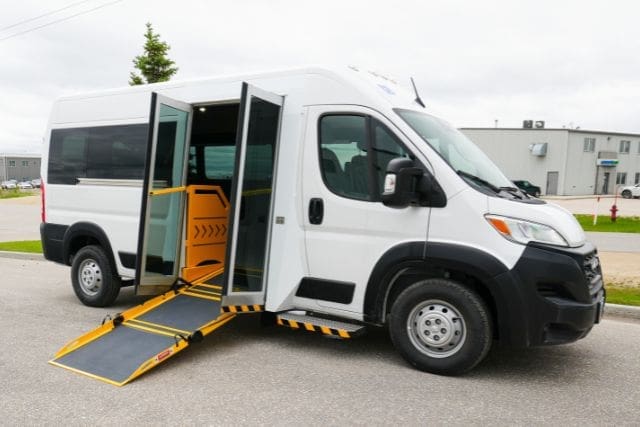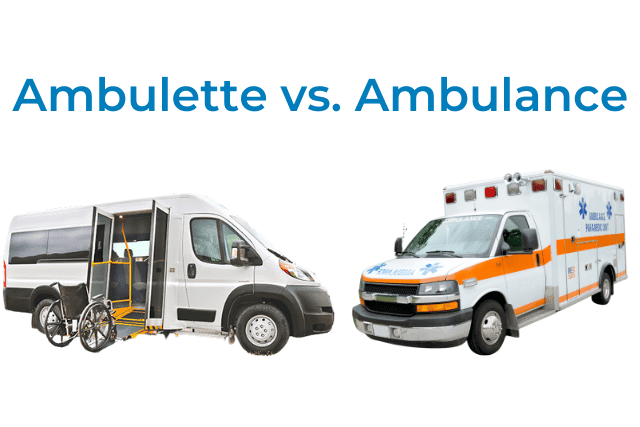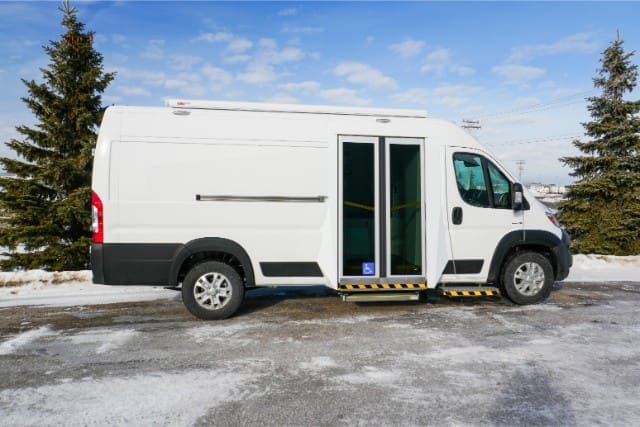Are you part of an organization trying to decide between purchasing an ambulette vs. ambulance? We know it can be confusing to figure out which vehicle best suits your needs.
You want to provide the best care and transportation for your clients, but you’re not sure which option is right for you. You might feel overwhelmed by all the choices and features to pick from.
Choosing the wrong option can:
- Lead to operational challenges
- Cause client discomfort
- Create regulatory issues
- Cause unnecessary expenses
We understand how important this decision is for you, and we’re here to help make it easier.
At AVAN Mobility, we specialize in creating solutions that break down barriers to healthcare. With over ten years of experience in the industry, we’ve become experts at designing and manufacturing vehicles to meet all kinds of needs. Our commitment is to provide high-quality, reliable vehicles that help save lives.
In this article, you’ll learn about the differences between an ambulette and an ambulance. We’ll explore what each vehicle is designed for, the services it provides, and which one might be the best fit for your organization. Let’s dive in and clear up any confusion so you can make the best choice for your needs.
What’s an ambulette?

An ambulette is a vehicle that helps people get to places like the doctor or hospital when it’s not an emergency. Unlike an ambulance, which is for emergencies, an ambulette is for people who need extra help but don’t need urgent medical care.
Ambulettes are perfect for folks in wheelchairs, those who have trouble moving around, or anyone who needs some medical supervision during their ride. These vans are designed to make it easy and safe for people to get in and out of.
What services can you provide with an ambulette?
Ambulettes can do a lot of useful things. Here are some examples:
Non-emergency medical transportation: They can take patients to and from medical appointments, dialysis treatments, and physical therapy sessions.
Wheelchair transportation: Ambulettes are set up to safely transport people who use wheelchairs.
Stretcher transport: Some ambulettes can carry stretchers for patients who need to lie down during the ride.
Ambulatory services: They can help people who can walk but need a bit of assistance to get to their destination safely.
Transport for the elderly and disabled: Ambulettes are perfect for older adults or people with disabilities who need reliable and comfortable rides.
Community events and outings: Organizations can use ambulette services to take groups of people to community events or social gatherings.
For example, imagine an elderly man named Mr. Smith who needs to go to the hospital for a check-up. He needs a stretcher to lie down during the ride. An ambulette picks him up from his home, helps him onto the stretcher, and safely takes him to his appointment. The ride is smooth, and Mr. Smith feels safe the whole time.
What organizations would benefit from an ambulette?
Lots of different organizations can use ambulettes. Let’s look at a couple of examples so you can see if yours can benefit from one:
Healthcare providers: Hospitals and clinics can use ambulettes to take patients to and from appointments when they don’t need emergency care.
Senior care facilities: Nursing homes and assisted living places can use ambulettes to take residents to doctor visits or social events.
Nonprofits and community groups: These groups can use ambulette transportation to help people with mobility issues attend community events and get necessary services.
Schools: Schools with students who have disabilities can use ambulettes to make sure they get to school safely and comfortably.
Private transportation companies: Businesses that offer medical transportation services can add ambulettes to their fleet to provide more services and reach more clients.
In the next section, we’ll take a look at ambulances so you can get a better understanding of their differences.
What is an ambulance?

An ambulance is a vehicle designed for emergencies. Unlike an ambulette, which helps with non-urgent care, an ambulance handles medical emergencies. It also provides immediate care to people on the way to the hospital.
Ambulances have advanced medical equipment and are staffed by paramedics or emergency medical technicians (EMTs), who are specially trained for critical situations.
What services can you provide with an ambulance?
Ambulances offer many types of emergency services. Here are some key ones:
Emergency medical care: Ambulances provide life-saving care right away. This includes giving medications, doing CPR, and using defibrillators to restart a patient’s heart.
Quick transport to hospitals: Ambulances take patients to the nearest hospital for more treatment.
Advanced life support (ALS): Some ambulances have advanced medical equipment. Highly trained paramedics use this equipment to care for people in emergency situations.
Basic life support (BLS): Other ambulances offer basic life support services, which include checking vital signs and giving basic first aid.
Specialized transport: Ambulances can transport patients who need special care. This might range from newborn babies to those needing intensive medical support.
For example, if someone has a heart attack, an ambulance is sent right away. Paramedics arrive, give emergency care, and quickly take the patient to the hospital. The ambulance has everything needed to help the patient during the ride.
What organizations would benefit from an ambulance?
A lot of organizations can benefit from having ambulances. Here are some examples:
Hospitals: Hospitals need ambulances to respond to emergencies and bring patients to their emergency rooms quickly.
Fire departments: Fire departments often have ambulances to provide emergency medical services. You’ll find them at the scene of fires, accidents, and other emergencies.
Private ambulance services: Companies that offer emergency medical transportation can use ambulances. They use them to respond to 911 calls and other urgent medical needs.
Event organizers: Large events like concerts, sports games, and festivals often have ambulances on standby to handle any medical emergencies.
Industrial sites: Factories and construction sites may have ambulances to respond quickly to any accidents or medical emergencies on-site.
Should you choose an ambulette or an ambulance?
If your organization handles non-emergency medical transportation, like a senior care facility or a non-profit helping people with mobility challenges, an ambulette might be your best bet. Ambulettes are made for non-urgent trips and come with features like stretchers and securement systems to ensure safe, easy transportation. Choosing an ambulette can help avoid the high costs of using an ambulance for routine trips while still keeping your passengers safe and comfortable.
An ambulance is the way to go for emergency medical transportation, like a hospital or fire department. They’re equipped with life-saving tools like defibrillators and oxygen tanks and have trained EMTs or paramedics on board to provide immediate care. This way, patients get the critical attention they need on the way to the hospital, ensuring their safety in life-threatening situations.
Which one will you choose?

You made it to this article looking for more information on ambulettes vs. ambulances. If you’ve made it this far, you now have a better understanding of what sets them apart. We hope you have more clarity on which option will work for you.
Our goal at AVAN Mobility is to make sure you always have the most information before making a decision. Remember, a decision to purchase an ambulette or ambulance is a decision that could save lives.
Do you have any questions about what we’ve talked about in this article? Feel free to click the button below to talk to a mobility expert. We’ll do our best to guide you on the right path.
If you’re not ready to talk to someone yet, we have some other helpful resources you should check out.
Start with taking a look at our article comparing the Mobile Response Van and ambulances. You might find that it’s another option your organization may be interested in.
After that, you’ll probably have questions about what we do at AVAN Mobility. Read our article to learn more about us!





